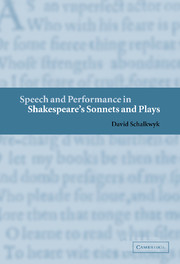Book contents
- Frontmatter
- Contents
- Acknowledgements
- Introduction: the sonnets
- 1 Performatives: the sonnets, Antony and Cleopatra and As You Like It
- 2 Embodiment: the sonnets, Love's Labour's Lost, Romeo and Juliet and Twelfth Night
- 3 Interiority: the sonnets, Hamlet and King Lear
- 4 Names: the sonnets, Romeo and Juliet, Troilus and Cressida and Othello
- 5 Transformations: the sonnets and All's Well that Ends Well
- Conclusion
- Bibliography
- Index
2 - Embodiment: the sonnets, Love's Labour's Lost, Romeo and Juliet and Twelfth Night
Published online by Cambridge University Press: 22 September 2009
- Frontmatter
- Contents
- Acknowledgements
- Introduction: the sonnets
- 1 Performatives: the sonnets, Antony and Cleopatra and As You Like It
- 2 Embodiment: the sonnets, Love's Labour's Lost, Romeo and Juliet and Twelfth Night
- 3 Interiority: the sonnets, Hamlet and King Lear
- 4 Names: the sonnets, Romeo and Juliet, Troilus and Cressida and Othello
- 5 Transformations: the sonnets and All's Well that Ends Well
- Conclusion
- Bibliography
- Index
Summary
It is one of the more telling ironies of literary history that a body of poems that proclaims its own capacity to rescue its addressees from the obscurity and ravages of time by immortalising them in the transcendental life of its own language should in fact have left their natures and identities a virtual blank. Despite attempts by literary biographers and historians to find out who the ‘dark lady’ and the ‘fair friend’ of Shakespeare's Sonnets were, the life that they lead – considered purely through the poems – is a linguistic or textual one. Whatever subjectivity or objectivity they enjoy appears at first sight to be merely grammatical, literally the outcome of the logical law that to speak about something entails nothing about its existence. To paraphrase Stephen Booth, the dark lady and the young man were almost certainly either actual historical people or fictions; the sonnets provide no explicit evidence on the matter.
The recent trend, beginning with the New Criticism and culminating in recent poststructuralist theory, of rejecting biographical or dramatic accounts of the sonnets in favour of their textually self-reflexive and self-enclosed nature, may be attributed to a growing and increasingly self-conscious obsession with this truth. This critical tendency has emphasised not only the multiple and irreducible complexities and ambiguities of the language of the sonnets (Stephen Booth, Helen Vendler), it has also sacrificed their objects of address to the overriding idea that the poems are interesting above all for the way in which they constitute the subjectivity of their creator (Joel Fineman).
- Type
- Chapter
- Information
- Speech and Performance in Shakespeare's Sonnets and Plays , pp. 59 - 101Publisher: Cambridge University PressPrint publication year: 2002



